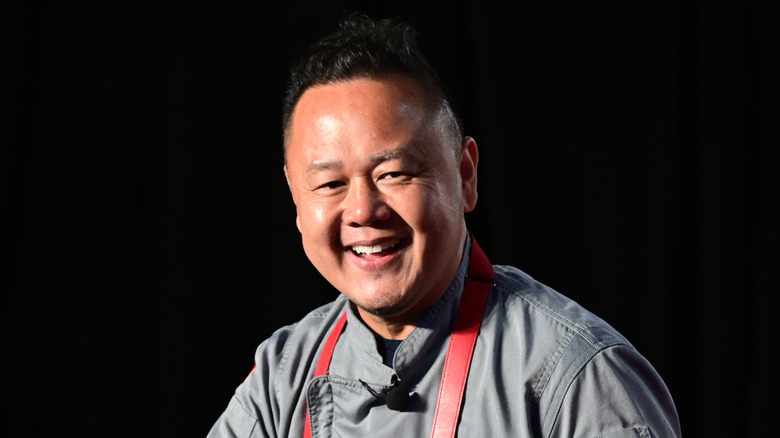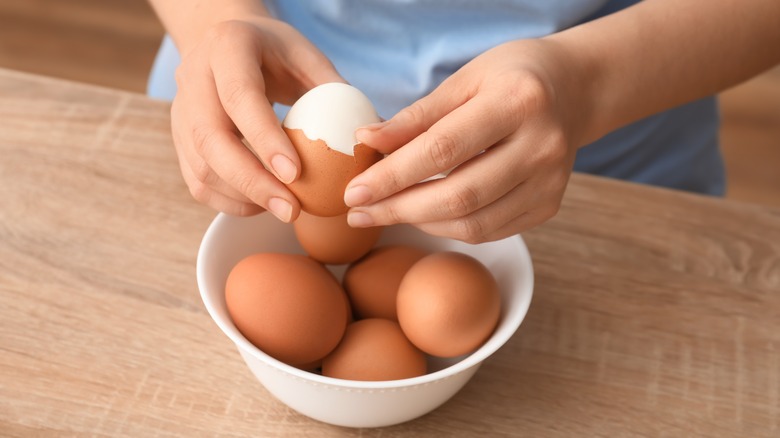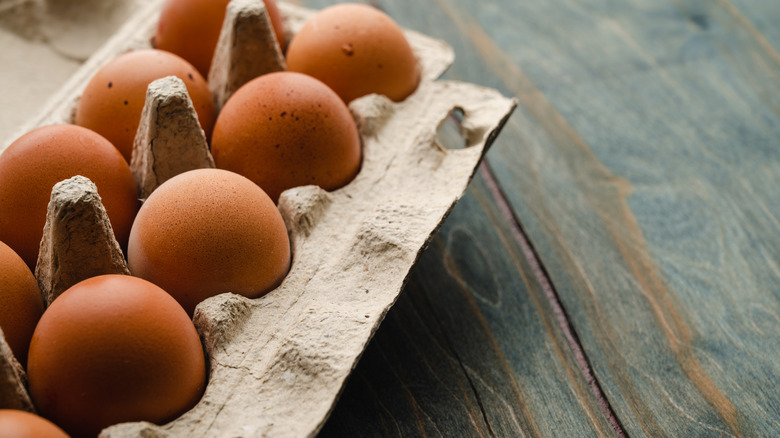Jet Tila's Baking Soda And Needle Trick To Peel Boiled Eggs Faster
Boiled eggs are a great way to take some protein on the go. Not only are they portable, but they come in their own natural wrapper. They're also integral to a variety of dishes, from egg salad sandwiches to deviled eggs. But peeling hard-boiled eggs (or even the soft-boiled kind) can be a pain. The shells are prone to sticking to the eggs and often break off in miniscule pieces that somehow find their way into your recipe, adding an unnerving crunch to a food that's meant to be completely smooth.
That's where Food Network star and Culinary Ambassador of Thai Cuisine Jet Tila's tricks come in handy. By following his advice and poking a needle size hole in the narrow, top end of the egg, followed by boiling it in water with baking soda, you'll get easy-to-peel eggs that won't have you fighting with slivers of shell. Instead, the shell will pretty much roll right off — saving time and frustration.
Combined, these two tricks make for easy peeling
Jet Tila showcases his method for quick and easy-to-peel boiled eggs on Instagram where — instead of measuring out a specific amount of baking soda — he just shakes the open box over a pot of water. While some people may insist on anywhere from a quarter of a teaspoon to a heaping one, Tila's imprecise formula is simple enough to show that you can't go wrong as long as you use some.
"I'm going to poke a little hole right in the top of that egg, to kind of vent that egg," he says as he uses a safety pin to make a teeny tiny hole in the shell. Off-camera someone asks how he can be sure that this process won't cause the egg to crack, but Tila explains that the shells are stronger than that and can easily withstand the puncture from a needle.
As for peeling the egg after boiling and cooling, Tila demonstrates how the shells roll right off mostly still connected to one large piece — and in a matter of seconds. He credits the baking soda and the 'air vent' made by the needle with the ease of peeling. It's unclear why the hole helps ease peeling, but it could have something to do with the membrane separating from the shell during boiling.
Why you might want to let the eggs sit out before boiling
In addition to poking a needle size hole in the shells and adding baking soda to the water, there is another important trick to keep in mind when boiling eggs. If you've ever struggled with your eggs cracking open while they're boiling or parts of the egg peeling away with the shell, then you'll want to make sure to let the eggs sit out for a few minutes beforehand. This will allow the eggs to reach room temperature, preventing the cold-to-hot shock that can cause cracking or parts of the egg to fuse to the shell.
Naturally, you don't want to let the eggs sit out on the counter all morning. Nor do you want to poke a hole and then let them rest a while. If you take them out of the fridge ahead of filling the pot with water and adding baking soda, that should be sufficient. Then just poke the holes and add them to the water as it reaches a rolling boil. After the eggs are done, you will still want to give them the usual cool down via some ice water. Doing so will prevent the eggs from continuing to cook in the residual heat, heading off those smelly grayish yolks overboiled eggs are prone to, and further ease the peeling process. By taking advantage of these tricks to boil eggs, you'll get shells that are easy to peel every time.



